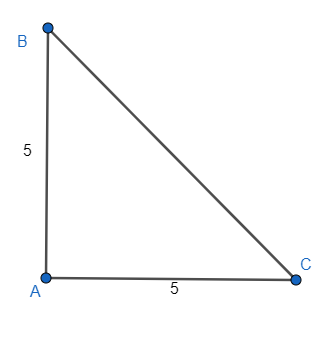
In $\Delta ABC$, $\cos A\cos B+\sin A\sin B\sin C=1$. Find the characteristics of the triangle.
A. equilateral
B. isosceles
C. right angled
D. obtuse angled
Answer
559.2k+ views
Hint: We first try to take the given equation and form the equation in the form of the sum of the positive terms and sum being 0. The equation gives us the fact that each term becomes 0. We solve those equations and find the relation between the angles and solve the problem.
Complete step by step answer:
We have been given that in $\Delta ABC$, $\cos A\cos B+\sin A\sin B\sin C=1$. We multiply the equation with 2 and get
$\begin{align}
& \cos A\cos B+\sin A\sin B\sin C=1 \\
& \Rightarrow 2\cos A\cos B+2\sin A\sin B\sin C=2 \\
\end{align}$
We have the identity formula of ${{\sin }^{2}}x+{{\cos }^{2}}x=1$ and applying that we get
$\begin{align}
& 2\cos A\cos B+2\sin A\sin B\sin C=2 \\
& \Rightarrow 2\cos A\cos B+2\sin A\sin B\sin C=\left( {{\sin }^{2}}A+{{\cos }^{2}}A \right)+\left( {{\sin }^{2}}B+{{\cos }^{2}}B \right) \\
\end{align}$
We try to form the ratios of cos in one side and the ratios of sin in the other side.
We get $\left( {{\cos }^{2}}A+{{\cos }^{2}}B-2\cos A\cos B \right)+\left( {{\sin }^{2}}A+{{\sin }^{2}}B-2\sin A\sin B\sin C \right)=0$
Now we convert them into squares and leave the rest as it is
${{\left( \cos A-\cos B \right)}^{2}}+{{\left( \sin A-\sin B \right)}^{2}}+2\sin A\sin B-2\sin A\sin B\sin C=0$
We form the last common part as ${{\left( \cos A-\cos B \right)}^{2}}+{{\left( \sin A-\sin B \right)}^{2}}+2\sin A\sin B\left( 1-\sin C \right)=0$.
We can see that all three terms contained above are positive, as while first two terms are squares and hence positive, third term is positive as sine ratio of angles A and B is positive (as they are less than $\pi $ being angles of a triangle) and $\left( 1-\sin C \right)$ too will be positive as $\sin C<1$.
But we have the sum as 0 which gives that every single term will be 0.
So, $\cos A-\cos B=0$ which gives $\cos A=\cos B\Rightarrow A=B$.
We have $\sin A-\sin B=0$ which gives $\sin A=\sin B\Rightarrow A=B$
And lastly $1-\sin C=0$ which gives $\sin C=1=\sin \dfrac{\pi }{2}\Rightarrow C=\dfrac{\pi }{2}$.

The two angles are equal which gives equal sides.
The triangle becomes isosceles and right angled.
So, the correct answer is “Option B and C”.
Note: In the third part of the equation $2\sin A\sin B\left( 1-\sin C \right)=0$, we already had the fact that the sine ratios are positive and that’s why we eliminated $2\sin A\sin B$. For the first two equations we took a particular solution instead of a general solution as we are dealing with angles of a triangle which can’t be greater than $\pi $ as sum.
Complete step by step answer:
We have been given that in $\Delta ABC$, $\cos A\cos B+\sin A\sin B\sin C=1$. We multiply the equation with 2 and get
$\begin{align}
& \cos A\cos B+\sin A\sin B\sin C=1 \\
& \Rightarrow 2\cos A\cos B+2\sin A\sin B\sin C=2 \\
\end{align}$
We have the identity formula of ${{\sin }^{2}}x+{{\cos }^{2}}x=1$ and applying that we get
$\begin{align}
& 2\cos A\cos B+2\sin A\sin B\sin C=2 \\
& \Rightarrow 2\cos A\cos B+2\sin A\sin B\sin C=\left( {{\sin }^{2}}A+{{\cos }^{2}}A \right)+\left( {{\sin }^{2}}B+{{\cos }^{2}}B \right) \\
\end{align}$
We try to form the ratios of cos in one side and the ratios of sin in the other side.
We get $\left( {{\cos }^{2}}A+{{\cos }^{2}}B-2\cos A\cos B \right)+\left( {{\sin }^{2}}A+{{\sin }^{2}}B-2\sin A\sin B\sin C \right)=0$
Now we convert them into squares and leave the rest as it is
${{\left( \cos A-\cos B \right)}^{2}}+{{\left( \sin A-\sin B \right)}^{2}}+2\sin A\sin B-2\sin A\sin B\sin C=0$
We form the last common part as ${{\left( \cos A-\cos B \right)}^{2}}+{{\left( \sin A-\sin B \right)}^{2}}+2\sin A\sin B\left( 1-\sin C \right)=0$.
We can see that all three terms contained above are positive, as while first two terms are squares and hence positive, third term is positive as sine ratio of angles A and B is positive (as they are less than $\pi $ being angles of a triangle) and $\left( 1-\sin C \right)$ too will be positive as $\sin C<1$.
But we have the sum as 0 which gives that every single term will be 0.
So, $\cos A-\cos B=0$ which gives $\cos A=\cos B\Rightarrow A=B$.
We have $\sin A-\sin B=0$ which gives $\sin A=\sin B\Rightarrow A=B$
And lastly $1-\sin C=0$ which gives $\sin C=1=\sin \dfrac{\pi }{2}\Rightarrow C=\dfrac{\pi }{2}$.

The two angles are equal which gives equal sides.
The triangle becomes isosceles and right angled.
So, the correct answer is “Option B and C”.
Note: In the third part of the equation $2\sin A\sin B\left( 1-\sin C \right)=0$, we already had the fact that the sine ratios are positive and that’s why we eliminated $2\sin A\sin B$. For the first two equations we took a particular solution instead of a general solution as we are dealing with angles of a triangle which can’t be greater than $\pi $ as sum.
Recently Updated Pages
Two men on either side of the cliff 90m height observe class 10 maths CBSE

What happens to glucose which enters nephron along class 10 biology CBSE

Cutting of the Chinese melon means A The business and class 10 social science CBSE

Write a dialogue with at least ten utterances between class 10 english CBSE

Show an aquatic food chain using the following organisms class 10 biology CBSE

A circle is inscribed in an equilateral triangle and class 10 maths CBSE

Trending doubts
The shortest day of the year in India

Why is there a time difference of about 5 hours between class 10 social science CBSE

Write a letter to the principal requesting him to grant class 10 english CBSE

What is the median of the first 10 natural numbers class 10 maths CBSE

The Equation xxx + 2 is Satisfied when x is Equal to Class 10 Maths

What is the missing number in the sequence 259142027 class 10 maths CBSE




